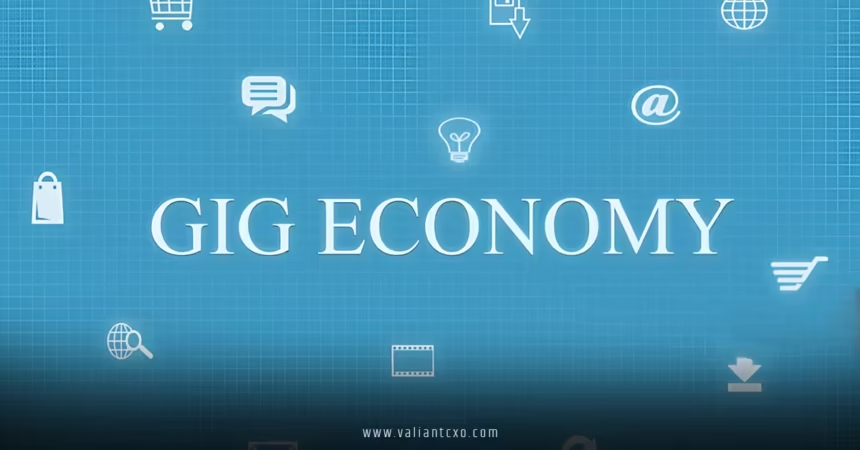Insurance for the Gig Economy: A US Perspective is more than just a buzzword—it’s a lifeline for millions of Americans navigating the wild, exhilarating, and sometimes unpredictable world of gig work. Picture this: you’re a rideshare driver weaving through city traffic, a freelance graphic designer burning the midnight oil, or a food delivery cyclist dodging raindrops. The gig economy offers freedom, flexibility, and the chance to be your own boss, but it also comes with a glaring gap: traditional insurance models often leave gig workers high and dry. So, what’s the deal with insurance for gig workers in the US? Why is it so critical, and how can you make sense of the options? Let’s dive into the nitty-gritty and unpack why Insurance for the Gig Economy: A US Perspective is a game-changer.
What Is the Gig Economy, Anyway?
Before we get to the insurance part, let’s set the stage. The gig economy is like a bustling marketplace where people trade their skills, time, or resources for short-term, flexible work. Think Uber drivers, TaskRabbit handymen, or Upwork freelancers. In the US, the gig economy has exploded—over 36% of workers participated in it by 2023, according to Statista. It’s not just a side hustle anymore; for many, it’s a full-time grind.
But here’s the catch: gig workers aren’t employees. They don’t get the cozy benefits of a 9-to-5, like employer-sponsored health plans or workers’ compensation. This makes Insurance for the Gig Economy: A US Perspective a critical puzzle to solve. Without proper coverage, a single accident, illness, or lawsuit could derail your hustle. So, how do you protect yourself in this freewheeling world?
Why Insurance for the Gig Economy: A US Perspective Matters
Imagine driving for Lyft, and—bam!—you get into a fender-bender. Your personal auto insurance might not cover you because you were “on the clock.” Or picture a freelance photographer whose camera gear gets stolen at a gig. Without specialized insurance, you’re out thousands of dollars. These aren’t hypotheticals; they’re real risks gig workers face daily.
Insurance for the Gig Economy: A US Perspective fills these gaps. Unlike traditional insurance, which assumes you’re tethered to one employer, gig insurance is designed for the fluidity of freelance life. It’s about protecting your income, assets, and peace of mind when the unexpected hits. From health coverage to liability protection, the right insurance can be the difference between a minor hiccup and a financial disaster.
The Unique Risks Gig Workers Face
Gig workers are like tightrope walkers without a safety net. Here are some risks that make Insurance for the Gig Economy: A US Perspective essential:
- No Employer Safety Net: Traditional employees often have workers’ comp or health benefits. Gig workers? You’re on your own.
- Income Volatility: One bad month—or a single accident—can wipe out your earnings.
- Liability Exposure: Whether you’re delivering food or consulting, a mistake could lead to a lawsuit.
- Asset Risks: Your car, laptop, or tools are your livelihood. Damage or theft hits harder when you’re a gig worker.
These risks aren’t just scary—they’re real. That’s why understanding Insurance for the Gig Economy: A US Perspective is non-negotiable.
Types of Insurance for the Gig Economy: A US Perspective
So, what kinds of insurance should gig workers consider? The options can feel like a maze, but let’s break it down into bite-sized pieces. Each type of coverage addresses specific risks, ensuring you’re not left vulnerable.
Health Insurance
Let’s start with the big one: health insurance. Gig workers don’t get employer-sponsored plans, so you’re left to navigate the Health Insurance Marketplace or private providers. Plans vary widely, from high-deductible options to comprehensive coverage. For example, a Bronze plan might cost less upfront but leave you with hefty out-of-pocket expenses, while a Gold plan offers more protection at a higher premium.
Why does this matter? A single hospital visit can cost thousands. In 2024, the average cost of a three-day hospital stay was $30,000, per the Kaiser Family Foundation. Without health insurance, that’s a debt trap waiting to happen. Insurance for the Gig Economy: A US Perspective means finding a plan that balances cost with coverage, especially if your income fluctuates.
Auto Insurance for Rideshare and Delivery Drivers
If you drive for Uber, Lyft, or DoorDash, your personal auto insurance likely won’t cut it. Most policies exclude coverage when you’re using your car for commercial purposes. Enter rideshare insurance, a hybrid that bridges personal and commercial coverage. Companies like Geico and Progressive offer rideshare endorsements, while platforms like Uber provide contingent coverage when you’re online.
Here’s the kicker: without proper auto insurance, an accident could leave you liable for damages, medical bills, or even lost wages. Insurance for the Gig Economy: A US Perspective includes specialized auto policies to keep you on the road without breaking the bank.
Liability Insurance
Liability insurance is your shield against lawsuits. If you’re a freelancer offering professional services—like consulting or design—errors or omissions could land you in hot water. For instance, a client might sue if your marketing campaign flops or your code crashes their website. General liability insurance covers bodily injury or property damage, while professional liability (aka errors and omissions insurance) protects against claims of negligence.
For gig workers, liability insurance is like a seatbelt: you hope you never need it, but you’re glad it’s there. Insurance for the Gig Economy: A US Perspective often includes tailored liability policies for freelancers and contractors.
Property and Equipment Insurance
Your tools are your livelihood. Whether it’s a laptop for coding, a camera for photography, or a van for deliveries, losing your gear can stop your hustle cold. Property insurance covers damage or theft of your equipment, ensuring you can get back to work quickly. Some policies even cover rented gear, which is a lifesaver for gig workers who don’t own everything outright.
Disability and Income Protection Insurance
What happens if you’re injured and can’t work for weeks? Disability insurance replaces a portion of your income if you’re sidelined by illness or injury. For gig workers, short-term disability plans are often more practical than long-term ones, given the fast-paced nature of gig work. Income protection insurance can also cover lost wages due to unexpected events, like a car breakdown or a canceled project.
Insurance for the Gig Economy: A US Perspective emphasizes flexibility—policies that adapt to your unpredictable income and lifestyle. It’s about building a safety net that catches you when life throws curveballs.
How to Choose the Right Insurance for the Gig Economy: A US Perspective
With so many options, picking the right insurance feels like choosing a Netflix show—overwhelming but necessary. Here’s a step-by-step guide to make it easier:
Step 1: Assess Your Risks
What’s your gig? Driving, consulting, creating? Each role has unique risks. A delivery driver needs robust auto coverage, while a freelance writer might prioritize professional liability. Make a list of your biggest vulnerabilities—equipment, health, lawsuits—and start there.
Step 2: Compare Providers
Not all insurance companies understand the gig economy. Look for providers with gig-specific policies, like Stride Health for health insurance or Hiscox for liability coverage. Compare premiums, deductibles, and coverage limits to find the best fit.
Step 3: Check Platform Policies
Some gig platforms offer limited coverage. For example, Uber provides liability and collision coverage when you’re on a trip, but it’s bare-bones. Understand what your platform offers and fill the gaps with supplemental insurance.
Step 4: Budget Wisely
Gig income can be feast or famine, so choose policies that align with your cash flow. High-deductible plans might save money upfront, but ensure you can cover the deductible if something goes wrong.
Step 5: Read the Fine Print
Insurance policies are like contracts with your ex—full of surprises if you don’t read carefully. Check for exclusions, like “commercial use” clauses in auto policies, and ask questions before signing up.
Insurance for the Gig Economy: A US Perspective is about finding coverage that fits your unique needs, not a one-size-fits-all solution. It’s like tailoring a suit: it should feel just right.
The Cost of Insurance for the Gig Economy: A US Perspective
Let’s talk money. Insurance isn’t cheap, but neither is losing your livelihood. Costs vary based on your gig, location, and coverage needs. Here’s a rough breakdown:
- Health Insurance: $200–$600/month for individual plans via the Marketplace.
- Rideshare Insurance: $20–$100/month as an add-on to personal auto policies.
- Liability Insurance: $30–$100/month for general or professional coverage.
- Property Insurance: $10–$50/month, depending on equipment value.
- Disability Insurance: $25–$100/month for short-term plans.
These are ballpark figures, but they show that Insurance for the Gig Economy: A US Perspective doesn’t have to break the bank. Shop around, bundle policies, and look for discounts to keep costs manageable.
The Future of Insurance for the Gig Economy: A US Perspective
The gig economy isn’t slowing down, and neither is the insurance industry’s response. Insurtech startups like Stride and Next Insurance are shaking things up with flexible, app-based policies tailored for gig workers. Meanwhile, traditional insurers are catching on, offering rideshare endorsements and freelancer-friendly plans.
But there’s a bigger question: should gig platforms step up? Some argue companies like Uber or TaskRabbit should provide benefits like traditional employers. Others say that’s a pipe dream, given the gig economy’s freelance model. Either way, Insurance for the Gig Economy: A US Perspective will keep evolving as more workers demand coverage that matches their lifestyle.
Conclusion
Insurance for the Gig Economy: A US Perspective isn’t just a nice-to-have—it’s your safety net in a world of uncertainty. Whether you’re dodging traffic as a delivery driver or burning the midnight oil as a freelancer, the right insurance protects your income, assets, and peace of mind. From health and auto coverage to liability and disability plans, there’s a policy for every gig worker’s needs. The key is to assess your risks, compare options, and choose coverage that fits your hustle. Don’t let a single accident or lawsuit derail your dreams. Take charge, get insured, and keep gigging with confidence.
FAQs
1. Why is Insurance for the Gig Economy: A US Perspective so important for gig workers?
Gig workers lack employer benefits like health plans or workers’ comp, making personal insurance critical to cover risks like accidents, lawsuits, or equipment loss.
2. What types of insurance should a rideshare driver consider?
Rideshare drivers need specialized auto insurance to cover commercial use, plus health and disability insurance to protect against injuries or income loss.
3. How can freelancers find affordable Insurance for the Gig Economy: A US Perspective?
Freelancers can shop via platforms like Stride Health, compare providers, and choose high-deductible plans to balance cost and coverage.
4. Do gig platforms provide any insurance coverage?
Some platforms, like Uber, offer limited liability and collision coverage during active gigs, but you’ll need supplemental Insurance for the Gig Economy: A US Perspective for full protection.
5. How do I know which insurance is right for my gig?
Assess your risks (e.g., equipment, lawsuits, health), compare providers, and read policy details to ensure your Insurance for the Gig Economy: A US Perspective fits your needs.
For More Updates !! : valiantcxo.com


